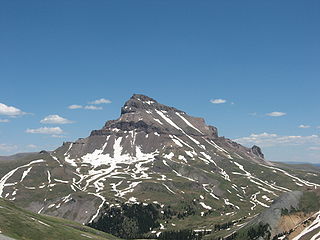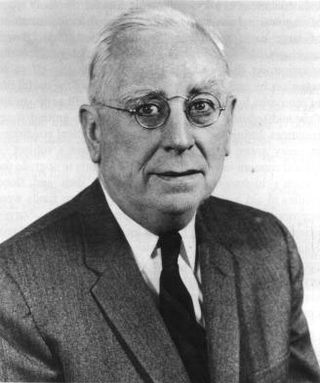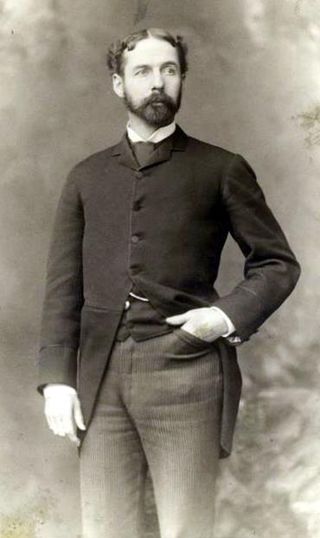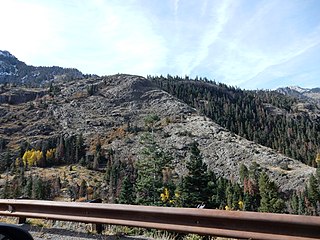Related Research Articles

The San Juan Mountains is a high and rugged mountain range in the Rocky Mountains in southwestern Colorado and northwestern New Mexico. The area is highly mineralized and figured in the gold and silver mining industry of early Colorado. Major towns, all old mining camps, include Creede, Lake City, Silverton, Ouray, and Telluride. Large scale mining has ended in the region, although independent prospectors still work claims throughout the range. The last large scale mines were the Sunnyside Mine near Silverton, which operated until late in the 20th century and the Idarado Mine on Red Mountain Pass that closed down in the 1970s. Famous old San Juan mines include the Camp Bird and Smuggler Union mines, both located between Telluride and Ouray.

The Colorado Mineral Belt (CMB) is an area of ore deposits from the La Plata Mountains in Southwestern Colorado to near the middle of the state at Boulder, Colorado and from which over 25 million troy ounces of gold were extracted beginning in 1858. The belt is a "northeast-striking zone defined by: a Proterozoic shear zone system ; a suite of Laramide-aged plutons and related ore deposits ; a major gravity low ; low-crustal velocities; and high heat flow ." Mining districts include:

The City of Leadville is a statutory city that is the county seat, the most populous community, and the only incorporated municipality in Lake County, Colorado, United States. The city population was 2,633 at the 2020 census. It is situated at an elevation of 10,158 feet (3,096 m). Leadville is the highest incorporated city in the United States and is surrounded by two of the tallest 14,000 foot peaks in the state.
Argentine Pass, elevation 13,207 ft (4,025 m), is a high mountain pass that crosses the Continental Divide in the Front Range of the Rocky Mountains of central Colorado in the United States. Argentine Pass is located on the crest of the Front Range along the boundary southwest of Georgetown and is the highest named vehicle-accessible pass in the state.
The Top of the Rockies National Scenic Byway is a National Scenic Byway and Colorado Scenic and Historic Byway located in the high Rocky Mountains of Eagle, Lake, Pitkin, Summit counties, Colorado, United States. The 115-mile (185 km) byway showcases the two highest peaks of the Rocky Mountains: Mount Elbert at elevation 14,440 feet (4,401.2 m) and Mount Massive at elevation 14,428 feet (4,398 m). The byway connects with the Collegiate Peaks Scenic Byway at the junction of Colorado State Highway 82 and U.S. Highway 24.

Mount Sherman is a high mountain summit in the Mosquito Range of the Rocky Mountains of North America. The 14,043-foot (4,280 m) fourteener is located 6.8 miles (11.0 km) east by south of the City of Leadville, Colorado, United States, on the drainage divide separating Lake County from Park County. The mountain was named in honor of General William Tecumseh Sherman.

Gold mining in the United States has taken place continually since the discovery of gold at the Reed farm in North Carolina in 1799. The first documented occurrence of gold was in Virginia in 1782. Some minor gold production took place in North Carolina as early as 1793, but created no excitement. The discovery on the Reed farm in 1799 which was identified as gold in 1802 and subsequently mined marked the first commercial production.
Gold mining in Colorado, a state of the United States, has been an industry since 1858. It also played a key role in the establishment of the state of Colorado.

Uranium mining in Colorado, United States, goes back to 1872, when pitchblende ore was taken from gold mines near Central City, Colorado. The Colorado uranium industry has seen booms and busts, but continues to this day. Not counting byproduct uranium from phosphate, Colorado is considered to have the third largest uranium reserves of any US state, behind Wyoming and New Mexico.
Silver mining in Colorado has taken place since the 1860s. In the past, Colorado called itself the Silver State.

Ralph Jackson Roberts (1911–2007) was an American geologist and research scientist with the USGS. He is credited with the discovery of the Carlin and Battle Mountain Gold Belts, which make up the richest gold-mining region in Nevada as well as the United States.

The Leadville mining district, located in the Colorado Mineral Belt, was the most productive silver-mining district in the state of Colorado and hosts one of the largest lead-zinc-silver deposits in the world. Oro City, an early Colorado gold placer mining town located about a mile east of Leadville in California Gulch, was the location to one of the richest placer gold strikes in Colorado, with estimated gold production of 120,000–150,000 ozt, worth $2.5 to $3 million at the then-price of $20.67 per troy ounce.

Thomas Brennan Nolan was an American geologist who was director of the United States Geological Survey (USGS) from 1956 to 1965. The mineral nolanite is named in his honor and he was an elected member of the American Academy of Arts and Sciences, the United States National Academy of Sciences, and the American Philosophical Society. He was generally known as Tom Nolan.

Samuel Franklin Emmons was an American geologist. He was born in Boston, Massachusetts. He graduated from Harvard University in 1861 and studied at the Ecole des Mines in Paris, France, from 1862 to 1864 and at the Freiberg (Saxony) mining school in 1865. In May 1867, he was appointed assistant geologist under Clarence King on the American geological exploration of the fortieth parallel, and in July 1879 became geologist in charge of the Colorado division of the United States Geological Survey. He traveled extensively throughout the United States in connection with his work, and in 1870 made a survey, along with A. D. Wilson, of Mount Rainier, the highest and most inaccessible peak in the Cascade Range. The largest glacier in the contiguous United States, Emmons Glacier, is located along their survey route and is named after Emmons.

Treasure Mountain, elevation 13,535 ft (4,125 m), is a summit in the Elk Mountains of western Colorado. The mountain is in the Raggeds Wilderness southeast of Marble. The massif has been the site of marble mining and a legend of lost French gold.

Colorado mining history is a chronology of precious metal mining, fuel extraction, building material quarrying, and rare earth mining.
Eagleville is a former populated place in Mineral County, Nevada that is now a ghost town.

Federal Mines Safety Act of 1910 was a United States statute passed for the purposes of establishing the United States Bureau of Mines as a federal agency of the United States Department of the Interior. The Act of Congress authorized investigations of mining methods with an emphasis regarding the safety of miners while recovering combustible fossil fuels and confronting occupational dust exposure.

The Uncompahgre Formation is a geologic formation in Colorado. Its radiometric age is between 1707 and 1704 Ma, corresponding to the Statherian period.

Mount Tweto is a 13,672-foot (4,167 m) mountain summit on the boundary shared by Lake County and Park County, in Colorado, United States.
References
- ↑ Ogden, Tweto. "MI-16 1979 Geologic Map of Colorado". Coloroado Geological Survey Publications. Colorado Geological Survey. Retrieved 28 June 2018.
- 1 2 3 Warner, L.A. (1987). Memorial of Ogden L. Tweto 1912-1983. (full text PDF) (Report). Vol. 72. American Mineralogist. p. 127. Retrieved 5 December 2014.
- ↑ Tweto, O. 1979. Geologic map of Colorado. U.S. Geological Survey, Map G77115.
- ↑ Ogden Tweto (1968) Leadville District, Colorado, in Ore Deposits of the United States 1933-1967, New York: American Institute of Mining Engineers, p.681-705
- ↑ Tweto, Ogden; Sims, Paul K. (1963). Precambrian Ancestry of the Colorado Mineral Belt. (abstract with link to PDF) (Report). Vol. Bulletin 74. Geological Society of America. pp. 991–1014. Retrieved 2014-03-02.
- ↑ "Mount Tweto". Geographic Names Information System . United States Geological Survey, United States Department of the Interior . Retrieved May 6, 2023.